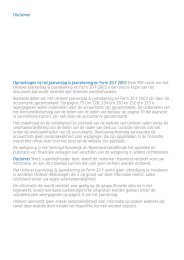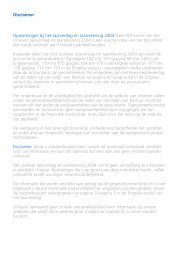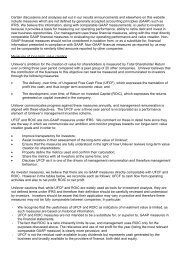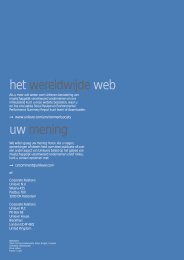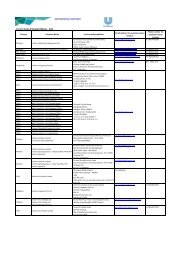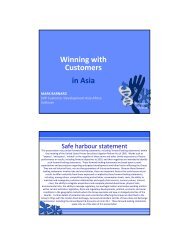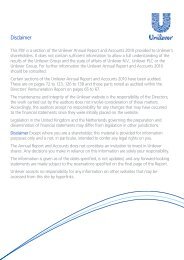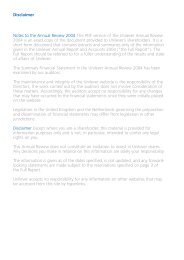Unilever Sustainable Living Plan Progress Report 2011
Unilever Sustainable Living Plan Progress Report 2011
Unilever Sustainable Living Plan Progress Report 2011
You also want an ePaper? Increase the reach of your titles
YUMPU automatically turns print PDFs into web optimized ePapers that Google loves.
20 <strong>Unilever</strong> <strong>Sustainable</strong> <strong>Living</strong> <strong>Plan</strong> <strong>Progress</strong> <strong>Report</strong> <strong>2011</strong><br />
REDUcInG GHG In LAUnDRY<br />
AnD MAnUFAcTURInG<br />
redUce greenhoUse gas<br />
eMissions FroM Washing<br />
clothes<br />
OUR TARGETS<br />
reduce the greenhouse gas<br />
impact of the laundry process by:<br />
3.2 concentrating our liquids and<br />
compacting our powders.<br />
3.3 reformulating our products to<br />
reduce greenhouse gas emissions<br />
by 15% by 2012.<br />
3.4 encouraging our consumers to<br />
wash at lower temperatures and<br />
at the correct dosage in 70% of<br />
machine washes by 2020.<br />
l<br />
l<br />
l<br />
OUR PERFORMANCE<br />
8% of our portfolio in our top<br />
14 countries was made up of<br />
concentrated and compacted<br />
products at end 2010, compared<br />
to our baseline of 4% in 2008.<br />
We continue to make good<br />
progress in reformulating our<br />
products to reduce greenhouse<br />
gas emissions. With the<br />
majority of our powders already<br />
reformulated we are on track to<br />
meet our 2012 target.<br />
We are encouraging consumers<br />
to use the right dosage through<br />
specially designed caps and we<br />
communicate the benefits of low<br />
temperature washing on our<br />
packs and online.<br />
concentrating our laundry products<br />
helps reduce greenhouse gas emissions<br />
– as we need fewer raw materials, less<br />
packaging and fewer lorries to transport<br />
the products.<br />
In our fast-growing markets in Asia and<br />
Africa most clothes are washed by hand<br />
in ambient temperatures and so the<br />
laundry process is less greenhouse gas<br />
intensive. The challenge will be to ensure<br />
that when people in these markets<br />
acquire washing machines they continue<br />
to wash at low temperatures.<br />
redUce greenhoUse gas<br />
eMissions FroM oUr<br />
ManUFactUring<br />
OUR TARGETS<br />
3.5 By 2020 co2 emissions from<br />
energy from our factories will be<br />
at or below 2008 levels despite<br />
significantly higher volumes.<br />
this represents a 63% reduction<br />
per tonne of production and a<br />
43% absolute reduction (versus<br />
a 1995 baseline).<br />
3.6 We will more than double our use<br />
of renewable energy to 40% of our<br />
total energy requirement by 2020.<br />
We recognise that this is only a<br />
first step towards a long-term<br />
goal of 100% renewable energy.<br />
3.7 all newly built factories will aim to<br />
have less than half the impact of<br />
those in our 2008 baseline.<br />
l<br />
l<br />
l<br />
OUR PERFORMANCE<br />
601,500 fewer tonnes of co2 from<br />
energy † produced in <strong>2011</strong> than in<br />
2008 (a reduction of 20% per tonne<br />
of production † ).<br />
compared to 1995, this represents<br />
a 55% reduction in absolute<br />
terms. †<br />
at end <strong>2011</strong> renewable energy<br />
contributed 20% † of our total<br />
energy use compared to 15.8%<br />
in 2008.<br />
during 2010–11 we incorporated<br />
sustainability improvements<br />
into every aspect of the design<br />
specification for our new factories.<br />
these improvements will be<br />
incorporated in all new designs<br />
from 2012 onwards.<br />
our reduction of 20% per tonne of<br />
production since 2008 has been<br />
driven predominantly by the purchase<br />
of renewable electrical energy and<br />
the use of biomass in our boilers.<br />
This is complemented by continuous<br />
improvement programmes across<br />
our sites.<br />
† <strong>2011</strong> data is preliminary, see page 41.<br />
ManUFactUring co2<br />
and energy savings<br />
The biggest contributors to our reductions<br />
in co2 and energy were:<br />
n electricity purchased for all factories<br />
in Europe and canada is now from<br />
renewable sources<br />
n the introduction of three new biomass<br />
boilers in India in <strong>2011</strong><br />
n the installation of combined<br />
heat and power systems in many<br />
of our European factories over<br />
2008-<strong>2011</strong>. By the<br />
end of <strong>2011</strong> this led<br />
to savings of over<br />
€10 million a year.<br />
delivering co2 savings<br />
our UK business identified inefficiencies<br />
in trucking laundry products across<br />
Europe. By double stacking products,<br />
we achieved a 60% reduction in vehicle<br />
kilometres and a 38% reduction in<br />
co2 emissions.<br />
In Brazil we switched deliveries from<br />
São Paolo to the north-east of the country<br />
from road to sea.<br />
This achieved a<br />
reduction of over<br />
5,000 tonnes of<br />
co2 a year.



